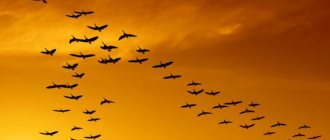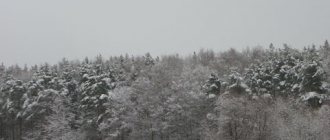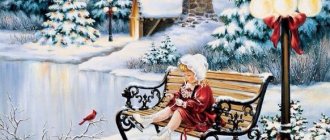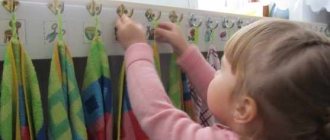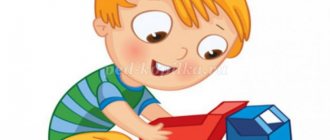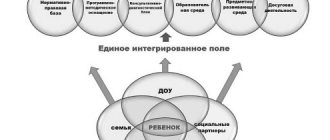Preschool children show special interest in the surrounding nature, its elements and phenomena. Home lessons on the topic “Seasons” should teach the child to distinguish the characteristic signs of spring, summer, autumn, and winter. It would be good if classes were based on joint observations and visual reinforcement of the material.
Spring changes
Spring is a time of year similar to early morning. Nature awakens from winter sleep. The sun's rays begin to warm the frozen ground. Everything around comes to life, filling the air with cheerful sounds.
The last frosts are still making themselves felt, but we can already note the three first signs of the coming spring:
| Sign | Description |
| Snow melting | The days are getting a little warmer and the snow lying on the roadsides is beginning to settle. Its top layer hardens, forming dense ice. Melted snow takes on a grayish tint and gradually turns into streams. |
| The sound of drops | At the same time as the snowdrifts, the icicles begin to thaw. Droplets of water falling from the roofs ring, breaking on the asphalt and forming numerous puddles. |
| Weather variability | In early spring the weather changes frequently. Winter is in no hurry to retreat; you can often see snow or rain outside the window. Frosts are possible. However, the sun appears more and more often, and the cold is replaced by warmer days. Gradually there are more and more of them. |
Differences in practice
First of all, draw the child’s attention to the changes in his life that began to occur with the passing of winter and the onset of spring. Place two types of clothes next to each other: winter and spring, and show your baby the difference between winter jackets, hats, boots, etc. from spring. Ask your child why these differences exist and why one jacket is warmer than another, one hat is thicker than another, etc. If you walked with your child for, for example, one hour in winter, and two hours in spring, ask if he noticed this difference. Tell us why your walk time has now increased. Watch the melting snow and “crying” icicles outside. Go with your baby to a park or forest, listen to the birdsong: in the spring it becomes more sonorous and cheerful. When picking up your child from kindergarten, ask if he knows why they came to pick him up in the winter when it was already dark outside, and in the spring at this time it is still light outside. Talk in a language the child can understand about the differences that occur in the length of winter and spring nights and days.
Changes in wildlife
Plants, animals, birds, and insects rejoice at the beginning of spring. It is interesting to observe how representatives of wildlife react to spring changes.
Plants
Under the influence of solar heat and light, the entire plant world begins to awaken. The soil becomes warm and moist - these are favorable conditions for plant development. Nutrients accumulated in the roots move to the “tops”.
At this time, the following processes are observed:
- appearance of early grass;
- germination of primroses (snowdrops);
- swelling of buds on trees and shrubs;
- punching green leaves;
- flowering plants.
Animals
With the onset of spring, wild animals begin to show increased activity. This is due to warming temperatures and the discovery of sufficient food in the forest environment.
The spring period of life of four-legged animals is characterized by the following phenomena:
- awakening hibernating animals (bears, badgers, hedgehogs);
- the birth of young (hares, squirrels, foxes, wolf cubs) and feeding them with milk;
- active acquisition of “adult” food: grass, young shoots, tree bark, insects;
- molting - a change from thick winter wool to a thinner one, in some animals (such as a hare, squirrel, arctic fox, ermine, weasel) is accompanied by a change in color;
- in horned representatives (elk, roe deer) - the growth of a new pair of antlers.
Birds
Significant changes can also be observed in the environment of birds:
- return of migratory birds (rooks, starlings, larks, lapwings, swallows, cuckoos, swifts, storks);
- nest construction;
- hatching eggs and feeding chicks;
- change of plumage in some varieties (for example, in partridges the white feather cover is replaced by brown-gray);
- joyful birdsong from early morning until the evening.
Insects
With the arrival of spring warmth, the first insects appear. Flies, mosquitoes, and butterflies wake up before everyone else. Soon you will notice bees and bumblebees collecting sweet nectar from young flowers. At the height of the season, ladybugs appear, ready to protect plants from harmful insects. When it gets really warm, you can see real cockchafers in parks and squares.
Characteristic signs of the onset of natural spring phenomena
The season of spring in the world around us is a mysterious and exciting event, since it occurs with such characteristic signs of rapidly changing natural phenomena as:
- Abundant melting of snow - when spring daylight hours noticeably lengthen, and the bright sun, rising high above the horizon, tries to shine longer, giving off more and more of the day's tangible heat. Under the influence of these intense processes, the deep, frozen snow that has accumulated over the winter begins to actively melt.
- Formation of icicles - the slow melting of snow forms spring drops, which on a warm day flow down drop by drop from numerous roofs of houses. In the evening, when the sun goes below the horizon, the air temperature cools sharply and the flowing drops instantly freeze.
- The appearance of thawed patches - under the influence of the heat of the daytime rays of the bright sun, dark areas of wet earth melted from snow appear in the open spaces of the hills, standing out sharply against the snow-white background of the winter landscape.
- Ice drift on the river - under the influence of the scorching spring sun, warm wind and continuous water flow, the ice fields become thinner and gradually burst, setting in motion huge masses of slowly melting ice floes.
- Uncontrollable flood is a prolonged influx of numerous streams of water into deep rivers with flooding of nearby floodplains. Due to the abundant melting of snow, the water regime quickly changes and the water level instantly rises, accompanied by the river overflowing its banks.
All these five signs of the onset of spring in inanimate nature are the main seasonal phenomena. In living nature, there are spring phenomena that are unique to it -
- early flowering of plants and the movement of juices in them from the roots to the top,
- swelling of buds, blossoming of leaves and appearance of flowers,
- the arrival of migratory birds and the polyphonic singing of birds,
- awakening of animals from hibernation and shedding of fur,
- the birth of animals and the birth of young chicks,
- feeding offspring of birds and raising the younger generation of animals,
which, of course, are associated with weather and annual seasonal warming of the climate, which promises heavy rainfall, subsequently changing the living conditions of numerous flora and fauna.
At this spring time, the following appear more and more often:
- morning fogs and light drizzles,
- dangerous hail precipitation and May thunderstorms,
- a squally wind sharply changing its strength and direction and the arrival of persistent heat.
These are the many signs of the onset of real spring.
Spring in pictures
To consolidate the knowledge the child has acquired, it is worth using illustrations on the topic “What spring it is!”
Available materials can include:
- thematic drawings;
- cut pictures;
- cards with images on the topic.
Illustrations may show:
- spring flowers;
- migratory birds;
- insects;
- Stories from the life of animals in the spring.
You can invite your child to draw spring as he imagines it, and then discuss the details of the drawing with him. It would be appropriate to learn several short poems on the topic with your child, and then select suitable images for them. You can make illustrations in the form of appliqués yourself using cut-out pictures. It’s good to prepare riddles about spring in advance along with the answers shown on small cards.
Children's cognitive abilities are maximized when using visual materials, especially if a serious lesson is taught in a light playful way.
Signs of Spring – a creative activity for children (2.5 – 3 years and older).
- Seal
Details Author: Nalivaykina Lyudmila Published March 21, 2013
Despite the fact that March is ending soon, there are snowdrifts outside our window, snow is falling, and at night they promise minus 20 degrees. But we still welcome spring!
Recently, my daughter and I had a wonderful creative activity that helped us consolidate our knowledge about the signs of spring. I liked this activity because it is very creative and playful, and also because it can be done with children of different ages, and can be done individually or in a group.
First, of course, we became acquainted with the concept of “Spring” by watching a presentation about spring (they are already posted on the website: a simpler for kids and a more complex one for children from 2.5 years old).
And then we started creating .
To begin with, this tree appeared on the wall of our room:
At first the tree was winter. Therefore, we glued “snow” to it - lumps of cotton wool. And here this tree stood, lulled by the winter breath, and waited for the arrival of spring.
And this is exactly what we did this spring!
To begin with, the sun appeared in the sky. But it was winter and did not warm very well. That's why we painted him some warm rays!
With the rays, the sun immediately turned into spring and began to warm so much that the snow melted! (And that's why we tore it off).
The tree slowly began to wake up, and buds (lumps of play dough) began to swell on its branches.
And after some time, leaves sprouted from the buds! (We make leaves using the “smearing” technique - we smear the “buds” and turn them into leaves!).
And very soon the tree turned green and prettier!
Spring continued, and soon a bird that flew from warm countries settled on the tree.
Birds have a lot of work to do in spring! She definitely needs to build a nest to hatch chicks:
And at the foot of the tree the grass is already turning green:
And flowers grow:
And butterflies are flying in the air! My idea was to make butterflies like this:
- paint funny dots on one half of the wing, fold the butterfly in half, and then open it again - and the symmetrical design is ready!
But the young artist had her own plans for butterflies. She felt that minimalism is now in fashion with butterflies:
This is the spring tree we got:
After making a creative craft, we lost and said that in the spring:
— the sun begins to warm up;
- snow is melting;
- the buds swell on the trees and then the leaves sprout;
- birds fly from hot countries and breed;
— the grass turns green and flowers bloom;
— insects wake up.
Of course, we could continue to study the signs of spring further, but Dasha was already a little tired of this tree, and I decided to call it a day. If children are more diligent, then other signs of spring can be played out in the same way.
Well, in the process of creativity, we struggled with our restlessness in the following ways (we made this tree in several approaches and several days):
Top 16 primroses among shrubs and trees
Ten days after the start of sap flow, swelling of the buds becomes noticeable, in which rudimentary shoots are located under the protective bud scales.
Photo: Tom Brandt
Wind-pollinated trees and shrubs bloom before they are covered with leaves, or at the very beginning of their development.
Alder and hazel are the first to bloom in the second half of April, and among those pollinated by insects, willow. The buds of the willow are tightly covered with brown scales that look like caps.
Having shed them, the buds look like fluffy balls consisting of hairs that protect the flowers from sudden fluctuations in temperature and rain.
In April, most of the trees are still bare, but the integumentary scales of the swollen buds are already moving apart, and the tailbones of the leaves appear from them. The appearance of leaves. The young leaves of some trees are covered with a sticky fragrant substance, while others have a fluff that protects them from the cold.
The light green color of the trees is tender and transparent at this time.
At the end of April, bird cherry and birch buds bloom; in the first half of May - buds of maple, yellow acacia, apple and pear trees, and then - oak and linden.
In late spring, in the second half of May, the real blossoming of spring begins. Bird cherry blossoms, at the same time - black currant, a little later - wild strawberries and fruit trees, lilac, rowan and most herbaceous plants.
In the last days of May, the fruits of aspen and willow ripen.
The petals of apple and lilac flowers fall off - spring ends, summer begins.
Biology Spring phenomena in plant life
Spring is the time for nature to awaken. According to the calendar, spring begins on March 1st. In nature, spring comes into its own with the beginning of sap flow in the trees, earlier in the south and later in the north on March 1.
The spring movement of sap in trees and shrubs is the first sign of spring. It occurs after the soil thaws and water from the roots begins to flow into all organs of the plant. At this time leaves yet.
Water, accumulating in the cells of plant stems, dissolves the organic substances stored in them. These solutions move to the swollen and blossoming buds . Already in early March, spring sap flow begins in Norway maple, earlier than in other trees, and a little later in birch.
The second sign of spring is the flowering of wind-pollinated trees and shrubs.
Gray alder is the first to bloom in the central European part of the USSR. Its flowers are inconspicuous, but the blooming earrings of staminate flowers are clearly visible 123 . As soon as you touch an alder branch with earrings, the wind picks up a whole cloud of yellow pollen.
Pistillate alder flowers are collected in small grayish-green inflorescences. Next to them, the dry, blackened cones of last year's inflorescences are usually clearly visible.
Almost simultaneously with the alder, the hazel tree, which you met in the fall, blooms.
The staminate flowers of hazel develop in inflorescences - complex catkins, and the reddish stigmas of pistillate flowers protrude from generative (flower) buds.
Early flowering of alder, hazel and other wind-pollinated plants is a good adaptation to life in the forest.
Bare leafless branches do not impede pollination. Pollen picked up by the wind is freely transferred from one plant to another.
The flowering of coltsfoot is also a sign of the coming spring. This perennial herbaceous plant grows in open, sunlit places, on railway embankments, river banks, steep slopes and cliffs.
As soon as the snow melts, its scaly stems appear - flower stalks with bright yellow inflorescences, similar to the inflorescences of dandelions 124 . Large leaves of coltsfoot grow after its fluffy fruits ripen and disperse.
Coltsfoot received its unusual name for the uniqueness of its leaves. Their underside is covered with white, soft, felt-like hairs, and the upper side of the leaves is smooth and cold.
Coltsfoot blooms in early spring, before the leaves bloom, perhaps because its thick, long rhizomes contain reserves of nutrients deposited in the summer of last year.
Feeding on these reserves, flower shoots and fruits are formed.
The third sign of spring is the flowering of perennial herbaceous plants in the deciduous forest. In the middle zone they bloom almost simultaneously with coltsfoot. The first to bloom in the forest are the noble liverwort with azure flowers and the lungwort, then the oak anemone and buttercup 125 , corydalis 119 , spring primrose 126 , spring primrose 127 .
Interesting Facts
Nature in spring is surrounded by numerous myths and interesting facts.
If we talk about people living near the North Pole, then in the spring they will definitely notice the sun sliding across the horizon in the sky. This is confirmation that the six months of the polar day are coming. And at the South Pole, this phenomenon indicates that 6 months of polar night are approaching. It is at the South Pole that spring occurs from September to November.
The spring equinox, observed in our country on March 20-21, means the period when the day begins to become longer than the night.
The Egyptian Sphinx was positioned by the ancient Egyptians in such a way that it clearly indicates the sunrise on the day of the vernal equinox. And the ancient Greeks believed that the first day of spring is the day when the goddess of fertility Persephone returns after a long stay in the underworld.
In America, Groundhog Day is still celebrated to this day. Every year on February 2 in the city of Punxsutawney, a groundhog is pulled out of its hole, which by default has the name “Phil.” If he suddenly sees his shadow, it means that winter still has 6 weeks to “rule”. If the groundhog doesn’t see her, doesn’t get scared and doesn’t hide in a hole, then spring has already come.
Poetry
Sparrows What do the sparrows sing about on the last day of winter? - We survived! - We made it! - We are alive! We are alive! V. Berestov March Loose snow darkens in March The ice on the window is melting, The bunny is running around the desk And along the map on the wall. S. Marshak Spring Tale The fish hit the ice together, And ice drift began on the river. V. Berestov Winter is angry for a reason. Winter is angry for a reason. Her time has passed - Spring is knocking on the window and driving her out of the yard. And everything began to fuss, Everything was forcing Winter out - And the larks in the sky Already started ringing the bell... Fyodor Tyutchev
Riddles, poems, proverbs and sayings about spring
Don’t forget that riddles, poems, proverbs and sayings can perfectly convey the spring mood, tell about the features of this time of year, revealing to the child such an interesting and diverse world of nature. If you reinforce your experiments with snow with a cheerful spring poem and ask your child a few riddles, the lesson on the given topic will turn out great. Riddles The snowball is melting, the meadow has come to life. The day is coming. When does this happen? Everyone says goodbye to the snow, Flowers are blooming, Beautiful weather - What time of year? The streams rang and the rooks flew in. The bee brought the first honey to the hive. Who can say, who knows when this happens? The loose snow melts in the sun, the breeze plays in the branches, the voices of birds are louder, which means that... (spring) has come to us
Spring transformation in different cultures
Nature in spring is not only about dramatic changes in the surrounding nature, but also a great holiday for the Slavs. March 22 is listed in the folk calendar as Lark Day. It is believed that it is on this date that the first 40 birds arrive every year, bringing spring on their wings. Believers hoped that their hooting on this day would attract warmth and a rich harvest. But March 22 is only the second or subsequent date for attracting spring; they often started hooting when spring itself spoke about it, the drops began, and the snow melted profusely.
For the Japanese, the blossoming nature in spring is its awakening, as for all peoples of the world. Setsubun-sai is a Shinto holiday that marks the end of the long winter season and the beginning of the long-awaited spring.
In medieval Britain, spring was celebrated on the first Monday in May. On the day of the celebration, the girls washed themselves with dew, and the boys competed in archery. But not all Englishmen celebrate it, because it was on the day of the spring celebration that Robin Hood was arrested.
In any case, spring is a time of change, when the soul awakens, new sensations appear, and there is nothing more magnificent than the riot of colors of nature.
Proverbs and sayings
Spring ice is thick, but simple; autumn is thin and tenacious. In spring the days are long, but the thread is short. (Too lazy to spin). Spring is red and hungry; Autumn is rainy and full. Spring is red with flowers, and autumn is red with pies. Rook on the mountain - spring is in the yard. Spring has come, so there’s no time for sleep. Winter scares spring, but it itself melts. Spring opens the keys and waters. Of course, the meaning of many proverbs, sayings and even nursery rhymes will need to be explained to the child. Why, for example, is there no time for sleep in the spring, how does spring open the springs and waters, why are the sparrows happy that they survived the winter? The more proverbs and sayings you explain to your child, the more erudite your child will be. Remember that the goal of all classes is not knowledge itself, but the full, comprehensive development of the child, instilling in him an inquisitive mind and a desire to constantly discover something new.
Experiments with snow
If the snow in your yard has not yet completely melted, collect it in a children's bucket before leaving home. Take a few pebbles, twigs or blades of grass with you from the street. When you get home, put a bucket of snow in the freezer until you are ready to do some simple experiments. You can use snow from the refrigerator for such activities. Place the brought pebbles, branches or grass on a tray or in a deep plate, and cover it all with snow on top. Tell your child that this is the snow slide he used to ride in the yard, only a small one. Then come up with “sunshine”. This could be a table lamp or a magnifying glass that lets in the sun's rays. Show your child what will happen if the sun shines far from the “ground” (from the tray with snow): the snow lies as it was. This is winter. Now show your child spring: bring the “sun” closer and wait until the snow begins to melt. Let the baby touch the wet snow with his finger and compare it with the snow that has not yet melted. After a while, the first “thawed patches” will appear under the snow - the stones and twigs that you placed under the snowdrift will be visible. Draw your baby's attention to them. Wait until all the snow melts and only a puddle remains. Say that this water will be absorbed into the ground and, having drunk from it, the grass and flowers will begin to gain strength and grow. Make a small snowman out of snow and place it in a container that will hold all the water formed after the snow melts. Show your baby a cheerful snow man and place him on a windowsill flooded with sunlight or under a switched-on table lamp. From time to time, take your child to the snowman and ask questions about how your little man has changed and why. Imperceptibly, you can change the snowman's cheerful smile to a sad expression, thereby noting that the time of winter is coming to an end, which means spring is coming, the snow is melting, and the snowmen are slowly disappearing, turning into a puddle. Fill a bowl with loose snow and make a “snowfall” over the tray. Tell your child that it snows in winter because it is cold. Then wait for the “fallen” snow to melt, pour the water into a small children’s watering can and show your child how it rains. Explain that in the warm season it rains instead of snow. If you don't have a watering can, you can pour water through a small kitchen strainer.
Outdoor games on the theme “Spring”
Outdoor games with a spring theme will be interesting for children. Who will find it first Players (you can play this game together with your baby) are given tasks like: - find a flower - find an ant - find a sign of spring (for older children) Whoever finds a given object first wins. Who is more? This game is similar to the previous one, but given “spring” objects need to be found in as large quantities as possible (who will find and show more ants, flowers, etc.) Contrasts Players are given the task of finding contrasts, for example, find a flower bud and exactly such a blossoming flower, find a branch without leaves and with leaves, without buds and with buds, dry and green grass, etc. Whoever finds it faster wins. Spring on the sidewalk As soon as the snow melts and the ground dries, you can safely take out the crayons. Let the spring theme be visible in your child’s first drawings, because it was the warm spring sun that allowed the child to do such an interesting activity as drawing with crayons.
Gray whales set off on a long voyage
In the spring, the world's two pods of gray whales begin their migration to the northern seas.
The first herd, the Chukchi-Californian one, leaves the Gulf of California, where the whales winter, and heads to the northern seas of Russia - the Chukchi, Bering and Botfort Seas. In the warm waters of the Gulf of California, gray whales give birth to calves, which also begin a journey of 16 thousand kilometers. “When whales leave our waters, I know it's spring,” says Ken Peterson, an associate at the Monterey Bay Aquarium in California. The second pod of gray whales winters near Korea, and in the summer returns to the Sea of Okhotsk, on the shelf of northeastern Sakhalin.
Blooming buds
When passing by trees with swelling buds, do not miss the opportunity to show them to your baby. Together, look at and compare the branches of different trees. On some, the buds will already begin to bloom, on others they will not yet be visible. Cut a small branch with swollen buds and place it in water at home. Show it to your baby several times a day so he can watch the leaves bloom in the warmth. Explain why the branch began to bloom faster in the warmth of your home than outside. Say that after a while all the trees that grow outside the window will bloom just like this branch.
Sprouts
You can clearly show the process of changes in plants and their growth by germinating several seeds. Take “live” (not old, rotten, untreated) sunflower, pumpkin, bean, wheat or other plant seeds. Moisten a small piece of cotton wool with water and place a few seeds in the wet cotton wool. Make sure that the cotton wool does not dry out and is always damp. Show your child what seeds look like before they are allowed to germinate. A few days later, when the sprouts begin to hatch, call the child again and show him how the grains have changed. Explain that these processes occur with seeds outside, in the ground. Then, when the hatched sprouts reach 0.5 cm, plant them in a flower pot. Let the baby water them. After some time, you will be able to observe small sprouts on the surface of the earth. When you walk with your baby outside, find such sprouts in the ground and show them what it looks like in nature.
